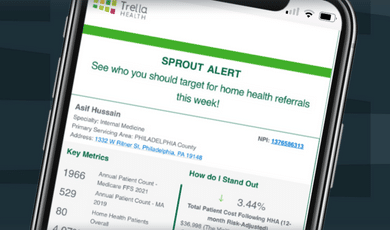Carter Bakkum, Senior Data Analyst, Healthcare Insights
Carter is a senior data analyst who works to turn complex, messy data into actionable intelligence. Carter studied economics and statistics at the University of Virginia before joining an economic consulting firm, where he supported expert testifying economic witnesses on behalf of fortune 500 healthcare companies. After the significant changes in the importance of data analytics during the pandemic, Carter joined the Trella team to dive deeper into the numbers to uncover the stories that drive our experience.Home Health, Hospice, and Skilled Nursing Baseline NPI Closure Rates: 2017 – 2019
By Carter Bakkum | February 10, 2022
Highlights:
- In a typical year, between 8% and 15% of post-acute care (PAC) National Provider Identifiers (NPIs) become inactive.
- Despite these inactivity rates, new entrants into the PAC market have only led to a slight decrease in active home health NPIs (1.7%) and an increase in hospice (16.9%) and skilled nursing (3.8%) NPIs.
- NPI turnover is expected in the competitive and ever changing post-acute care market.
Fears of Agency Closures Plague the Post-Acute Care Industry
In 2021 Skilled Nursing News published an article indicating a signal for the skilled nursing market: Skilled Nursing Facilities (SNFs) are closing in Maine. While an individual state may be an indicator for issues pervasive across the country – though Maine certainly has their own demographic reasons, the least of which being an inadequate replacement rate for the last 40 years – it’s well documented that post-acute care providers fear having to close their business. Predictions of company closures in the PAC industry is nothing new; Home Health Care News sounded the alarm in 2019 about how new regulations from CMS would result in a catastrophic number of home health agencies closing. While the main issues center around acute financial and staffing reasons brought on by the pandemic, a baseline level of agency closures is expected, especially in a market as competitive and dynamic as post-acute care.
What Were the PAC Agency Closure Rates Before the COVID-19 Pandemic?
Using access to 100% of Medicare Fee-For-Service (FFS) Part A and Part B claims, I investigated the number of active (defined as having any admissions in a quarter) agencies between 2017 and 2019 and identified National Provider Identifiers (NPIs) that became inactive between Q1 and Q4 2019. The results are summarized in the table below:
| Line of Business | Active Agencies 2017-2019 | Agency Closures in 2019 | Closure Rate |
| Home Health | 10,646 | 1,614 | 15.2% |
| Hospice | 5,022 | 398 | 7.9% |
| Skilled Nursing | 18,339 | 2,140 | 11.7% |
These results illustrate even in a “normal” year between 8% and 15% of active PAC NPIs become inactive. Some of these inactive NPIs may not be due to a specific agency’s closure. For example, if a larger company acquires an NPI they could dissolve that NPI and merge it with another. However, these results indicate that a certain level of NPI turnover is expected. However, while some agencies left the market, other players identified an opportunity to enter.
Despite the high inactivity rate for home health agency NPIs, the total number of active NPIs only decreased by 152 (1.7%) between Q1 2017 and Q4 2019. Further, the total number of active NPIs during the same time period for hospice and skilled nursing increased by 663 (16.9%) and 599 (3.8%), respectively.
Conclusion
Post-acute care has numerous smaller and mid-size businesses, which typically fail at a higher rate than larger, consolidated businesses, so these results are largely in line with economic expectations. Clearly, businesses see an opportunity to add value to the market enough to enter it. For further analysis into how these inactivity rates changed during the pandemic keep an eye out for the Industry Trend Report to be published by Trella Health in March 2022.
Trella Health is the leader in market intelligence for the 65+ population, with extensive data sets including Medicare FFS, Medicare Advantage, commercial payers, ACOs, and DCEs. For more insights into how to stand out as a preferred referral partner, schedule a demo today.













